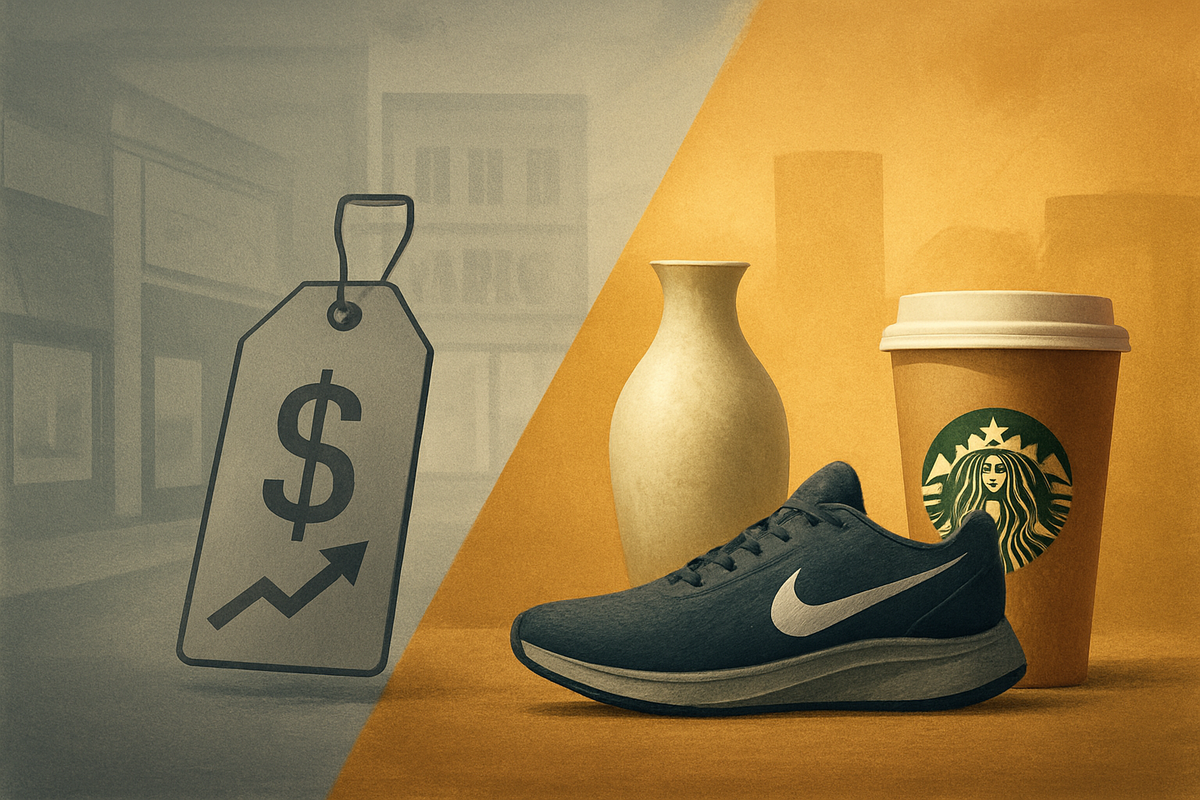
New York, NY – November 5, 2025 – The S&P 500's Consumer Discretionary Sector presented a paradox today, with an overall downturn for the segment contrasting sharply with stellar performances from select industry giants. While the broader sector, as tracked by the Consumer Discretionary Select Sector SPDR (XLY), reportedly declined by 1.7%, home furnishings retailer Williams-Sonoma (NYSE: WSM) defied the trend, surging an impressive +2.56%. This mixed bag of results offers a nuanced glimpse into consumer spending habits and underlying economic sentiment, suggesting a market grappling with uncertainty yet rewarding resilience and brand strength.
Today's trading session revealed a consumer landscape that is both cautious and discerning. The significant gains by companies like Williams-Sonoma, alongside Nike (NYSE: NKE) and Starbucks (NASDAQ: SBUX), indicate that while overall discretionary spending might be under pressure, specific brands with strong market positions, loyal customer bases, or compelling product offerings continue to capture consumer dollars. This divergence highlights a "flight to quality" within the discretionary space, where consumers prioritize trusted names even as broader economic anxieties persist.
Beneath the Surface: Sector Headwinds Meet Individual Triumphs
The immediate implications of today's market activity are clear: the Consumer Discretionary sector is not monolithic. While some reports indicated a slight rise in the overall S&P 500, the specific performance of the XLY ETF points to headwinds for the discretionary segment. This downturn aligns with prevailing economic sentiment, which has been leaning towards caution. The RealClearMarkets/TIPP Economic Optimism Index, for instance, registered a disappointing 43.9 in November 2025, marking the third consecutive month below the crucial 50-point benchmark, a level not seen since June 2024. This widespread unease among American consumers is largely attributed to persistent inflation and stubbornly high food prices, which continue to erode purchasing power and foster a conservative approach to non-essential spending.
Despite this gloomy backdrop, individual players carved out impressive gains. Williams-Sonoma (NYSE: WSM) led the charge, with its +2.56% increase showcasing robust demand for its home furnishings and cookware. This performance not only outpaced the S&P 500's daily movement (where it was positive) but also significantly outperformed the broader Retail-Wholesale sector, which saw a gain of 1.74%. The company's stock has demonstrated remarkable growth over the past year, with a 46.1% increase, signaling sustained consumer interest in home improvement and decor. Similarly, athletic footwear and apparel titan Nike (NYSE: NKE) saw its stock climb by +1.44%, while coffeehouse giant Starbucks (NASDAQ: SBUX) also posted a gain of over 2%, even amidst reports of potential barista strikes. These individual successes underscore the power of brand equity and targeted consumer appeal in an otherwise challenging environment.
Winners and Losers: Brand Strength as a Shield
Today's market movements clearly delineated the potential winners and those facing increased pressure within the Consumer Discretionary sector. Williams-Sonoma (NYSE: WSM) stands out as a significant winner, its +2.56% surge a testament to its enduring appeal in the home goods market. The company's focus on quality, design, and a strong omni-channel presence has allowed it to capture a segment of consumers who, despite broader economic concerns, are still willing to invest in their living spaces. This sustained demand for home furnishings suggests that a portion of consumers continue to prioritize comfort and aesthetics, potentially drawing from savings or reallocating budgets from other discretionary categories.
Beyond Williams-Sonoma, companies like Nike (NYSE: NKE) and Starbucks (NASDAQ: SBUX) also demonstrated their resilience. Nike's +1.44% gain reflects its long-standing market dominance, continuous product innovation, and strong global branding, which often allows it to weather economic fluctuations better than smaller, less established competitors. Starbucks' more than 2% rise, even amid labor concerns, highlights the persistent "affordable luxury" aspect of its offerings and strong consumer loyalty. These companies benefit from strong brand recognition and products that, for many consumers, represent either essential items (like comfortable shoes) or habitual treats that are hard to give up.
Conversely, the overall 1.7% decline in the Consumer Discretionary Select Sector SPDR (XLY) suggests that many other companies within the sector are likely struggling. Businesses offering less differentiated products, facing intense price competition, or catering to lower-income segments—who are more acutely impacted by inflation—are likely experiencing a significant pullback in demand. This environment could lead to increased promotional activity, margin compression, and potentially even consolidation among weaker players as consumers become more selective with their discretionary spending.
Wider Significance: A Nuanced Economic Barometer
The day's performance in the Consumer Discretionary sector serves as a crucial barometer for the broader economy, painting a picture that is more complex than a simple boom or bust. The prevailing consumer pessimism, driven by inflation and high food prices, points to an anticipated slowdown in overall discretionary spending, a significant component of the Gross Domestic Product. This trend aligns with earlier indications in 2025, where consumers expressed intentions to scale back on non-essential purchases, prioritizing necessities. The sector's overall decline today reinforces this underlying economic caution.
However, the strong performances of Williams-Sonoma, Nike, and Starbucks introduce a critical nuance: not all discretionary spending is created equal. This "flight to quality" suggests that in times of economic uncertainty, consumers gravitate towards established, trusted brands that offer perceived value, unique experiences, or products that resonate deeply with their lifestyles. For instance, WSM's success indicates that home-related spending remains robust for certain demographics, perhaps those less affected by inflation or those continuing to invest in hybrid work environments. This phenomenon can create ripple effects, potentially widening the gap between premium, resilient brands and their more vulnerable competitors.
Historically, periods of economic uncertainty often see a bifurcation in consumer behavior, where high-end or deeply entrenched brands maintain their footing while mid-tier or less differentiated offerings suffer. Today's market movements appear to fit this pattern, highlighting the increasing importance of brand equity, customer loyalty, and strategic market positioning. Regulatory or policy implications might arise if the economic slowdown intensifies, potentially leading to government interventions aimed at stimulating consumer spending, though no such immediate actions are directly tied to today's sector performance.
What Comes Next: Navigating the Selective Consumer Landscape
Looking ahead, the Consumer Discretionary sector is likely to remain a battleground where brand strength and strategic agility will be paramount. In the short term, companies will need to carefully monitor consumer confidence reports and inflation data, as these will heavily influence purchasing decisions. The "treat yourself" mentality, evident in the performance of Starbucks and Nike, might continue to provide a floor for certain types of discretionary spending, but larger, more significant purchases will likely remain subdued for many.
For companies like Williams-Sonoma (NYSE: WSM), the challenge will be to sustain growth amidst a potentially tightening consumer wallet. Continued innovation in product offerings, effective marketing, and efficient supply chain management will be critical. Other companies in the sector will need to adapt, potentially through more aggressive promotional strategies, cost-cutting measures, or by finding new niches that resonate with the cautious consumer. This environment could spur strategic pivots, encouraging companies to focus more on value, durability, or unique experiences rather than broad-based discretionary items.
Long-term possibilities include a further consolidation of market share among the strongest brands, as weaker players struggle to compete. Market opportunities may emerge for companies that can effectively tap into evolving consumer preferences, such as sustainable products or personalized services. Conversely, challenges will persist for those unable to differentiate themselves or who are overly exposed to highly sensitive economic segments. Investors should prepare for continued volatility and a highly selective market where fundamental strength and brand loyalty are key determinants of success.
Wrap-Up: A Market of Two Halves
Today's performance in the S&P 500's Consumer Discretionary Sector offers a compelling narrative of a market in flux. The overall decline of the sector, as reflected by the XLY ETF, serves as a stark reminder of the persistent economic anxieties fueled by inflation and consumer pessimism. This broad caution suggests that many American households are indeed pulling back on non-essential spending, prioritizing financial security in an uncertain climate.
However, the remarkable gains by companies such as Williams-Sonoma (NYSE: WSM), Nike (NYSE: NKE), and Starbucks (NASDAQ: SBUX) paint a more nuanced picture. These individual triumphs underscore the enduring power of strong brands, specific product appeal, and targeted consumer bases that remain willing to spend on perceived value or essential "comforts." This divergence highlights that even in a challenging economic environment, pockets of strength exist, driven by consumer loyalty and a selective approach to discretionary purchases.
Moving forward, investors should closely watch consumer confidence metrics, inflation trends, and the earnings reports of key discretionary players. The market will likely continue to reward companies with robust brand equity, innovative products, and efficient operations, while those lacking these attributes may face increasing pressure. The lasting impact of today's trading reinforces a critical lesson: in a complex economic landscape, understanding the underlying currents of consumer behavior and distinguishing between broad sector trends and individual company resilience is paramount for navigating the market successfully.
This content is intended for informational purposes only and is not financial advice






